Tyrol
Tyrol (/tɪˈroʊl, taɪ-, ˈtaɪroʊl/;[1] historically the Tyrole;[2][3][4] German: Tirol German pronunciation: [tiˈʁoːl]; Italian: Tirolo) is a historical region in the Alps—in Northern Italy and western Austria. The area was historically the core of the County of Tyrol, part of the Holy Roman Empire, Austrian Empire and Austria-Hungary, from its formation in the 12th century until 1919. In 1919, following World War I and dissolution of Austria-Hungary, it was divided into two modern administrative parts through the Treaty of Saint-Germain-en-Laye:
- State of Tyrol: formed through the merger of North and East Tyrol, as part of Austria
- Region of Trentino-South Tyrol: at that time still with Souramont (Cortina d'Ampezzo, Livinallongo del Col di Lana and Colle Santa Lucia) and the municipalities Valvestino, Magasa and Pedemonte, seized in 1918 by the Kingdom of Italy, and thus since 1946 part of the Italian Republic.
Tyrol Tirol (in German) Tirolo (in Italian) | |
|---|---|
 Flag
| |
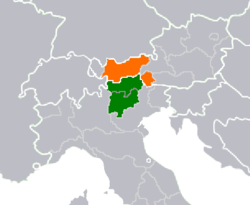 The southern part of Tyrol is located in Northern Italy and the northern part in Western Austria | |
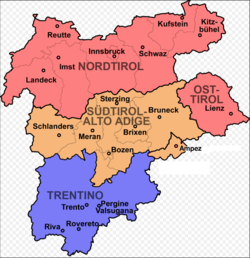 The region consists of present-day Tyrol–South Tyrol–Trentino Euroregion, including Cortina d'Ampezzo, Fodóm (Buchenstein), Col (Verseil), Valvestino, Magasa and Pedemonte | |
| Capital | Tirol (1027–1418) Merano (1418–1848) Innsbruck (1848–1918) Innsbruck (1918–today) |
| Official languages | German, Italian, Ladin, Cimbrian and Mòcheno |
| Demonym(s) | Tyrolean |
| Area | |
• Total | 26,674 km2 (10,299 sq mi) |
| Population | |
• 2017 estimate | 1,813,400 |
• Density | 68/km2 (176.1/sq mi) |
| Currency | Euro (€) (EUR) |
With the founding of the European region Tyrol-South Tyrol-Trentino the area has its own legal entity since 2011 in the form of a European Grouping for Territorial Cooperation.
Etymology
According to Egon Kühebacher, the name Tyrol derives from a root word meaning terrain (i.e. area, ground or soil; compare Latin: terra and Old Irish: tir); first from the village of Tirol, and its castle; from which the County of Tyrol grew.[5] According to Karl Finsterwalder, the name Tyrol derives from Teriolis, a late-Roman fort and travellers' hostel in Zirl, Tyrol.[6] There seems to be no scholarly consensus.
Geography
Location

Tyrol has an area of 26,673 km2. The region consists of the State of Tyrol, the Province of South Tyrol and the Province of Trento. In addition to the region belong the municipalities Cortina d'Ampezzo, Livinallongo del Col di Lana, Colle Santa Lucia and Pedemonte from the Region of Veneto and Valvestino and Magasa from the Region of Lombardy. The largest cities in Tyrol are Innsbruck, Trento and Bolzano.
The whole region of Tyrol is located in the Alps. Tyrol is bordered to the north by the state of Bavaria and to the east by the states of Carinthia and Salzburg. West of Tyrol lies the state of Vorarlberg and the canton of Grisons. On the southern side of Tyrol, the land is bordered by the regions of Veneto and Lombardy.
Important rivers in Tyrol are the Adige, Inn and Drau. The region is characterized by many valleys. Some of these valleys are still difficult to reach today. The most important valleys are the Inn Valley and Adige Valley. A large part of the population lives in these two valleys and also the five largest cities of Tyrol (Innsbruck, Bolzano, Trento, Merano and Rovereto) lie in these valleys. For centuries, the region has been known for transit trade. The most important trade route across the Alps, namely the Brenner Route, traverses the whole of Tyrol and is regarded as a connecting link between the Italian and German speaking areas.
Mountains
As the Tyrolean region is located in the Alps, the landscape is heavily influenced by the mountains. The highest mountains in Tyrol include:
- the Ortler 3905 m a.s.l.
- the Gran Zebrù 3851 m a.s.l.
- the Grossglockner; 3798 m AA
- the Monte Cevedale; 3769 m a.s.l.
- the Wildspitze; 3768 m AA
Across Tyrol, on the border between North and South Tyrol, runs the main chain of the Alps.[7] The main chain of the Alps geographically divides the Alps into a southern and northern half.
Biggest municipalities
Municipalities of Tyrol with over 10,000 inhabitants:
| Rank | Municipality | Inhabitants |
|---|---|---|
| 1 | Innsbruck | 132,236 |
| 2 | Trento | 117,417 |
| 3 | Bolzano/Bozen | 106,951 |
| 4 | Merano/Meran | 40,047 |
| 5 | Rovereto | 39,482 |
| 6 | Brixen/Bressanone | 21,688 |
| 7 | Pergine Valsugana | 21,363 |
| 8 | Kufstein | 18,973 |
| 9 | Laives | 17,780 |
| 10 | Arco | 17,588 |
| 11 | Riva del Garda | 17,190 |
| 12 | Bruneck/Brunico | 16,356 |
| 13 | Telfs | 15,582 |
| 14 | Eppan/Appiano | 14,900 |
| 15 | Hall in Tirol | 13,801 |
| 16 | Schwaz | 13,606 |
| 17 | Wörgl | 13,537 |
| 18 | Lana | 12,046 |
| 19 | Lienz | 11,945 |
| 20 | Imst | 10,371 |
Austria: 1 January 2017
Italy: 31 December 2016
Society
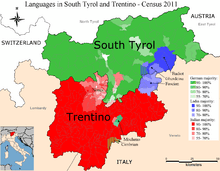
Language distribution
Tyrol can be subdivided into 5 different language groups. In addition to the majority languages such as German and Italian, languages such as Ladin, Cimbrian and Mócheno are also spoken. The last three languages are recognized as minority languages. These language groups are mostly located in the Trentino-Alto Adige region and are thus promoted and protected by the region. The Ladin language is also spoken outside the region in Souramont (Province of Belluno). Ladin is considered a Rhaeto-Romance language. The Cimbrian language is also used in various linguistic islands (Sette Comuni) outside the region of Trentino-South Tyrol. The Cimbrian language is considered an upper-Bavarian dialect.
Dialects
In the Austrian state of Tyrol, the German language is used by a large majority. As in many other regions in German-speaking countries, Tyrol also has its own German-language dialect. The Tyrolean dialect comes from the Bavarian dialect. In South Tyrol, the Tyrolean dialect was mixed with a few individual Italian words. Due to the difficult accessibility of the valleys in earlier years, many other valleys developed a slightly differentiated dialect compared to the Tyrolean. The Italian language group in South Tyrol mostly uses the Italian standard language and does not speak any dialect. The Ladin language also has no uniform language, so every valley also has a slight difference in Ladinia. The majority in Trentino speaks its own Italian dialect. This dialect is Lombard in western valleys, and is Venetian in central and eastern Trentino, mixed with words from the German-Bavarian dialect.
Heraldry
Although the details of the arms of Tyrol have changed over the centuries, one feature has remained more-or-less constant: argent, an eagle displayed gules, armed (and sometimes crowned) or.[8] Since 1983, the Province of South Tyrol has its own coat of arms. It is very similar to the coat of arms of the State of Tyrol. The Province wanted to emphasize the historical commonality of the countries.[9] The Province of Trento received its coat of arms in 1340 and refers to the prince-bishopric of Trento. The former County of Tyrol had a uniform coat of arms, which was slightly changed over the centuries.
- Coat of arms of Tyrol (State)
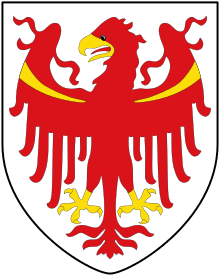 Coat of arms of the Province of South Tyrol
Coat of arms of the Province of South Tyrol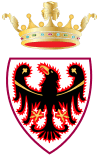 Coat of arms of the Province of Trentino
Coat of arms of the Province of Trentino Coat of arms of the Region of Trentino–South Tyrol
Coat of arms of the Region of Trentino–South Tyrol Coat of arms of the former County of Tyrol during the Austro-Hungarian Empire
Coat of arms of the former County of Tyrol during the Austro-Hungarian Empire
History
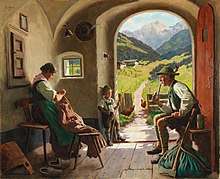
Prehistory
The earliest archaeological records of human settlement in Tyrol have been found in the Tischofer Cave. They date from the Palaeolithic, about 28,000-27,000 BP. The same cave has also yielded evidence of human occupation during the Bronze Age (very roughly, 4000-3000 BP (2000–1000 BC)).
In 1991, the mummified remains of a man who had died around 3300-3100 BC were discovered in a glacier in the Ötztal Alps, in Tyrol. Researchers have called him Ötzi (and also other names, including "The Iceman"). He lived during the Chalcolithic or Copper Age, after man had learned how to exploit copper but before man had learned how to make bronze. His body and belongings were very well-preserved, and have been subjected to detailed scientific study. They are preserved in the South Tyrol Museum of Archaeology, Bolzano, South Tyrol, Italy.
There is evidence that Tyrol was a centre for copper mining in the 4th millennium BC; for example, at Brixlegg. There is also evidence of the Urnfield culture (roughly 1300–750 BC).
Evidence of the La Tène culture (roughly 450–100 BC, during the Iron Age) has also been found; as has evidence of the Fritzens-Sanzeno culture from about the same period. Towards the end of that time, Tyrol began to be noted in Roman written records. The inhabitants may have been Illyrians, in the process of being displaced by Celts (perhaps themselves displaced from Noricum by Slavs). There are also indications that Adriatic Veneti may have been present in the south of the region. The Romans called them Rhaetians; although it is not clear whether that then meant a specific tribe or confederation of tribes, or was a broader term for the inhabitants of the area. They made wine barrels (an idea which the Romans took from them), and had their own alphabet.
Roman times
In 15 BC, Tyrol was conquered by Roman forces commanded by Drusus and Tiberius. The Romans established Raetia and Noricum as provinces of the Roman Empire. Raetia included Vinschgau, Burggrafenamt, Eisacktal, Wipptal, Oberinntal and parts of the Unterinntal. Noricum included Pustertal, Defereggen and parts of the Unterinntal to the right of the Ziller and the Inn. Bolzano and the extreme south of Tyrol belonged to the province of Venetia et Histria.
The inhabitants adopted the Latin Language called vulgar Latin or the everyday spoken version vs. the standardized written formal form, and combined it with their own languages. The result was Romansh, which is still spoken today and is one of the official languages of Switzerland.
The Romans constructed metalled roads guarded by forts through Tyrol to connect the Italian peninsula and the lands beyond; notably the Via Claudia Augusta and the Via Raetia. The Romans did not seem to find Tyrol an attractive area in which to build new towns, because there are few of them. One town they did build was Aguntum, near modern Lienz.
In late antiquity (from AD 476), Tyrol belonged to the Ostrogoths, and it was included in the Ostrogothic Kingdom. In 534, the Ostrogoths lost Merrano, Val Venosta and Passer to the Franks. The Ostrogothic Kingdom collapsed in 553, after being overrun by Bajuvarians from the north and Lombards from the south. The Lombards established the Duchy of Tridentum (or, Trent; roughly corresponding to modern Trentino) in south Tyrol. Slavic peoples, who had recently taken Carinthia from the Bajuvarians, settled in east Tyrol.
Middle Ages
Most of Tyrol came under the control of the Duchy of Bavaria (created c. 555). The southern parts, including Bolzano, Salorno, and the right bank of the Adige (including Eppan and Kaltern) remained under the Lombards. Tyrol was Christianised through the bishoprics of Brixen and Triento. The frontier remained the same though Carolingian and Ottonian times. The area was subject to Stammensgerechte (Ancient Germanic laws), such as Lex Romana Curiensis, Lex Alamannorum, Lex Baiuvariorum and Leges Langobardorum.

In 1027, Emperor Conrad II, in order to secure the important route through the Brenner Pass, allotted the left bank of the Adige (from Lana to Mezzocorona) to the Duchy of Bavaria. During the 12th century, the local nobility went further: they built Tyrol Castle in the modern comune of Tirol in South Tyrol, near modern Merano; and around 1140, established the County of Tyrol as a state within the Holy Roman Empire.
The Counts of Tyrol were at first Vogt (underlords) subject to the Bishoprics of Brixen and Triento; but they had other ideas. They expanded their holdings at those bishoprics' expense. They displaced competing nobles like the House of Eppan, and declared their independence from the Duchy of Bavaria; though not without dispute. In 1228, they conceded the Saalforste to the House of Wittelsbach, rulers of Bavaria; as a result, that area remains part of Bavaria to this day.
In 1253, rulership of the County passed by inheritance to the Meinhardiner family. In 1335, the last male heir to the Meinhardiner lands, Henry of Bohemia, died. His daughter, Margaret, thereupon became Countess of Tyrol; but her title was in doubt because of different laws in different lands as to what a woman could or could not inherit. She navigated her way between the competing claims of the Houses of Wittelsbach, Luxembourg and Habsburg by, in 1342, marrying Louis of Wittelsbach. Louis died in 1361. Margaret died in 1369, and bequeathed Tyrol to Rudolf of Habsburg. The various dynastic squabbles were resolved that same year by the Treaty of Schärding, under which (for suitable compensation) the Wittelsbachs agreed to relinquish their claims to Tyrol in favour of the Habsburgs.
When the Habsburgs took control of Tyrol, it had roughly its modern size. However, the Unterinntal downstream from Schwaz still belonged to Bavaria; the Zillertal and Brixental to Salzburg; Brixen and the Pustertal were episcopal territories, or part of the County of Gorizia. On the other hand, the Montafon and the Unterengadin were Tyrolean.
Tyrol was of great strategic importance to the Habsburgs. It controlled several important Alpine passes. It connected their landholdings in Further Austria. In 1406, as the Habsburg lands were split up by inheritance, Tyrol once again became a separate entity (a Landstand), in which the greater landowners had the right to be consulted (Mitspracherecht). During a confusing succession of events, in 1420 Frederick IV, Duke of Austria moved the capital of Tyrol from Meran to Innsbruck, and Meran lost its earlier importance.
Politics
Euroregion Tyrol-South Tyrol-Trentino
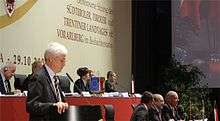
The Euroregion Tyrol-South Tyrol-Trentino was founded in 1998. The aim is to strengthen cooperation between the separated countries.[10] In several areas, such as mobility, agriculture, education and culture will be tried to promote exchange and to raise the awareness of the cultural and historical heritage of the region of Tyrol in the minds of the population. Cross-border projects will be initiated to improve the relationship between the different language groups. To represent common ideas and values in Europe, the Euroregion has a joint office in Brussels since 1995.[11] The headquarters of the office is in Bolzano. Joint decisions are taken by organized three diet (in German: Dreier-Landtag), which have been held since 1991 mostly every two to three years with the state Diets of Trento (provincial council of Trentino), Bolzano (provincial council of South Tyrol) and Innsbruck (state council of Tyrol (State)). In 2011, the region was institutionalized and since then has its own legal entity.
Political Parties
Political parties in the Italian part of Tyrol (provinces of Bolzano and Trento) include:
- Partito Democratico (PD)
- Südtiroler Volkspartei (SVP)
- Movimento Cinque Stelle (M5S)
- Lega Nord (LN)
- Greens
- South Tyrolean Freedom
- Die Freiheitlichen
- Trentino Tyrolean Autonomist Party (PATT)
The Austrian part of Tyrol shares the Austrian party system:
- Tiroler Volkspartei; organization of the ÖVP in the state of Tyrol, which has dominated local politics since 1945
- Social Democratic Party of Austria (SPÖ)
- Freedom Party of Austria (FPÖ)
- The Greens – The Green Alternative
- NEOS
The multiplicity of parties is due to the fact that Tyrol lies in two different nation states and thus are politically independent of each other. Another reason for the large number of parties is the great independence of the two Provinces of Bolzano and Trento. By the second statute of autonomy in 1972, the province of Bolzano acquired much of the region's competences and since then has been mostly independent of the province of Trento. The second autonomy statute enabled the linguistic minorities to be better protected.[12] The regional council of Trentino-South Tyrol, which consists of the two provincial councils of Bolzano and Trento, has less influence and competences. Thus, many parties determine their focus within the provinces. Other parties in Trentino-South Tyrol, especially in South Tyrol, were founded on the example of Austrian parties and have many similarities with the parties in Austria.
Economy
In the economic sector statistics are shown, which are based largely on numbers and data of the Euroregion Tyrol-South Tyrol-Trentino. It lacks individual communities that are outside the Euroregion. As there are no 10,000 inhabitants living in these communities, the statistics hardly distort the territory of Tyrol and the remaining 1.8 million inhabitants.
Tyrol had a total GDP of 67.6 billion euros in 2014. Divided into individual countries, the State of Tyrol generated 28.8 billion euros, the Province of South Tyrol 20.6 billion euros and the Province of Trentino 18.2 billion euros.[13] In GDP per capita (2015), that means 39,300 euros/capita in the State of Tyrol, 42,400 euros/capita in South Tyrol and 35,500 euros/capita in Trentino. The unemployment rate in the State of Tyrol is 3.2% (2014), in South Tyrol 3.4% (2017)[14] and in Trentino 4.6% (2017).[15] The Tyrol region is one of the wealthiest regions in Europe and, in terms of GDP/capita, is above the EU average, which amounted to 28,900 euros/capita in 2015. The Region of Trentino-South Tyrol is, in terms of GDP/capita, the wealthiest region in Italy with 37,813 euros/capita in 2015.[16]
Primary sector

Agriculture and forestry occupy a special position in Tyrol. The many small and medium-sized farms have shaped the landscape and culture in Tyrol for many centuries. In order to be competitive with larger farms outside Tyrol, there is a strong cooperative system in Tyrol. South of Tyrol, in the Region of Trentino-South Tyrol, the cultivation of apples and wine plays an important role. So every tenth apple in Europe comes from South Tyrol.[17] Known wines in Trentino-South Tyrol are the Vernatsch, the Lagrein, the Gewürztraminer and the Weißburgunder.[18] Livestock, grazing and forestry are important at higher elevations and in more northerly areas. Mainly cattle, sheep, goats and pigs are kept.[19] Accordingly, the production of milk and Tyrolean Speck in the farms is very important. Horses also play an increasingly important role in livestock, for equestrian sports and farm holidays. The Haflinger horses are known in the Tyrolean region and originate from Hafling, near Merano.[20]
Secondary sector
The first industrialization reached Tyrol late in the 19th century. Most of these were small businesses that were important only in the local area. A second wave of industrialization took place at the beginning of the 20th century. Particularly affected at that time was the city of Bolzano with the Italianization policy under Fascism in the 1920s.[21]
In 2011, approximately 10% of the workplaces in all parts of the country were active in the manufacturing sector. Thus lies Tyrol in the EU average at 10.3% (2011).[22] Important branches of industry in Tyrol are the food industry, wood processing and mechanical engineering. The industry in Tyrol consists mostly of small and medium-sized companies. The craft still plays a special role throughout the region. A large part of these craft businesses are still partially small-structured and family businesses. From an economic point of view, the energy sector is important in the secondary sector. Much of the electricity produced is generated by hydropower.
Tertiary sector
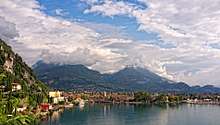
The most important sector in Tyrol is the tertiary sector. Especially tourism has a special position in this region. Due to the connection of the areas by the railway in the 19th century, many villages in Tyrol developed into popular tourism locations. The construction of the Brenner motorway in the 1960s gave region in the 20th century a renewed upswing in the tourism branch. Today, Merano, Kitzbühel, Cortina or Riva del Garda are among the most important tourism destinations in the Alpine region. In 2013, the Euroregion counted over 80 million[23] overnight stays in the Tyrolean region (to compare - Province of Rome in 2011: 25.8 million overnight stays).[24]
Also important for Tyrol is the trade. Among other things, the Exhibition of Bolzano has been a meeting point for Italian and German economy already for centuries. As a transit route country, more than 2.25 million trucks (2017) drove over the Brenner Pass.[25] This means that two times more trucks travel on the Brenner Route than in all four Alpine crossing roads in Switzerland together.[26]
Transport
Tyrol is known as a transit route. The most important route between northern and southern Europe, the Brenner route, traverses the entire region. At 1370 m above the Adriatic, the Brenner Pass is the lowest pass crossing of the main chain of the Alps. Due to the linguistic diversity and the climatic transition from temperate climate (alpine climate) to mediterranean climate, the area is regarded as a bridge between the Italian and German speaking countries.
Airports
The most important airport in Tyrol is Innsbruck Airport. With over one million passengers, it is the third largest airport in Austria.[27] Other airports in the region are in Bolzano and Trento. These do not offer regular scheduled flights and the Bolzano Airport currently offers charter flights. There are other small airfields in Toblach, Kufstein, St. Johann in Tirol, Reutte and Cortina. The airfield in Cortina was closed in 1976 due to a crash.
Road transport
Highways in Tyrol are the Brenner motorway and the Inntal motorway. The Brenner motorway runs from Innsbruck (in Austria A13) to Modena (in Italy A22). Together with the Inntal motorway from Innsbruck to Kufstein is the part of the European route E45. The dual carriageway from Merano to Bolzano (MeBo) ends in Bolzano South in the Brenner motorway. Important road section in Trentino, next to the Brenner motorway, is the SS 47 (Strada Statale 47), which connects via Sugana Valley Trento with Padova. A large part of this route is dual-lane and flows into the Brenner state road (SS 12). Due to the Alps, there are many mountain passes that connect valleys. The most important pass roads for transit trade are the Reschen Pass and Brenner Pass. Popular pass roads include the Stelvio Pass, Arlberg Pass, Karer Pass, Mendel Pass and the Gardena Pass. The Provinces of Trento and Bolzano have been responsible for the preservation and management of the state roads in their provinces since 1998.[28]
Railways
The most important railway line in Tyrol is the Brenner Line via the Brenner Pass. The Brenner Railway was opened in 1867 and runs from Innsbruck to Verona via the cities of Bolzano and Trento. Together with the Lower Inn Valley Railway in North Tyrol, this section of the route is part of the important European railway axis Berlin-Palermo, which connects northern Europe with southern Europe across the Alps. With the construction of the Brenner Base Tunnel and its completion in 2027, transit traffic on the rail will be promoted and relocated. After completion, the Brenner Base Tunnel, together with the Innsbruck bypass, will be the longest railway tunnel in the world at 64 km and will reduce the travel time between Bolzano and Innsbruck from 2 hours to 45 minutes.[29][30]
Further important railway lines in Tyrol are the Arlberg railway, Zillertal railway, Salzburg-Tyrol railway, Pustertal railway with continuation of the Drautal railway, the railway line Bolzano-Merano and the continuation of the Vinschgau railway, the Trento–Malè–Mezzana railway and the Valsugana railway, which leads from Trento to Venice over the Sugana Valley. Cross-border connections are offered only a few. The ÖBB travels over the Brenner Pass on the Eurocity trains and several regional trains connect South Tyrol with North Tyrol an East Tyrol. The Euroregion Tyrol-South Tyrol-Trentino has set itself the goal of promoting and expanding cross-border connections. The aim is to shift traffic through the Alps to sustainable means of transport, thus protecting the Alpine environment.[31]
Local public transport
Many villages and communities are difficult to reach because of the large differences in altitude, so the region sets much on ropeway concepts. Although most of the cable cars are located in ski resorts, they are also used for the local public transport. Known cable cars in Tyrol are the Ritten cable car in Bolzano, the Sardagna cable car in Trento and the Nordkette cable car in Innsbruck. Also funicular railways are being built to cope with the differences in altitude more quickly. Famous funiculars are among others the Hungerburgbahn in Innsbruck and the Mendel funicular in Kaltern.
Local public transport is usually offered with intercity buses or city buses. The city of Innsbruck has its own tram network. Another tram is located in Ritten. The cities of Bolzano, Merano and Trento formerly had their own tram network, but these were displaced and replaced by the city buses and private transport in the 50s and 60s.
Culture
The Tyrolean culture has been cultivated for several centuries and passed on to future generations. The state border between South and North Tyrol is more a political border and is considered less as a cultural border. Many traditions are cultivated throughout the Tyrolean region and show little differences. In all cultural areas such as food, dress or customs there are many similarities. Nevertheless, the individual language groups, especially the minority languages, try to maintain and promote their own linguistic identity.
Tyrolean cuisine
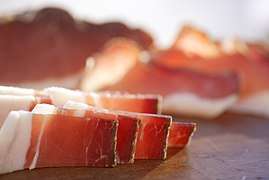
The Tyrolean cuisine has similarities with the Austrian cuisine and is characterized by its alpine influence. Also the historical influence of the former K.U.K. Monarchy can be found in the Tyrolean dishes. These include dishes such as goulash, Kaiserschmarrn and apple strudel which are consumed in large parts of the Danube monarchy and today still in Tyrol. Since the region is still relatively strong agricultural and peasant today, also many peasant dishes are offered on the farms. Schlutzkrapfen, boiled dumplings or cold cuts with bacon (in German: Speck) or grey cheese is eaten on the farms.[32]
The Tyrolean dishes show only slight differences throughout Tyrol. Due to the Mediterranean conditions in the southern part of Tyrol, a lot of wine is grown and is therefore also an important part of the Tyrolean dish, especially in South Tyrol and Trentino. Famous wines from this area are the Gewürztraminer, Pinot Blanc, Pinot Grigio and Chardonnay.[33] Furthermore, a lot of apples are grown in the Region of Trentino-South Tyrol. In this region also a food culture is cultivated with a mixture of Italian and Tyrolean specialties.[34][35]
Tyrolean Rifles

The Tyrolean Rifles were a militia organised in case of an attack on crown land, which required Tyrol to defend its territory. The militia consisted mostly of citizens and peasants who were responsible only for the defence of their own land and were not obliged to go to war on behalf of the Habsburg Monarchy. They were authorised by an order signed by Emperor Maximilian I in 1511 that remained valid until 1918. The Tyrolean Rifles became known in 1809 when Tyrolese peasants rose up and fought against the French-Bavarian occupation under Napoleon. The ensuing four Battles of Bergisel were led by Andreas Hofer. The Rifles were also used in World War I in 1915 on the Dolomite front. After the separation of Tyrol and the downfall of the monarchy, the companies also lost their task of defending their country. Nevertheless, they remained as a non-governmental organization. Today, the Rifles are responsible as an organization for the preservation of the Tyrolean culture and are always present at important political events in Tyrol.[36]
Customs
Many Tyrolean customs were created centuries ago and are passed on by the population for the next generations. Typical in the Alpine region are the many individual customs in the valleys. Due to the seclusion of the valleys, the locals developed their own customs. Many customs have been created by legends and narratives, others by the close connection to the church. There are also traditions that are cultivated everywhere in the Tyrolean region and do not differ from other valleys and villages. These customs give local people an identity and thus feel the community more connected.[37]
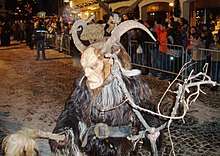
 Imster Schemenlaufen in Imst
Imster Schemenlaufen in Imst Herz Jesu Fire in whole Tyrol
Herz Jesu Fire in whole Tyrol
Sports
Tyrol is traditionally a winter sports country. Many athletes, such as Gustav Thoeni, Benjamin Raich, Carolina Kostner, Gregor Schlierenzauer, Toni Sailer and Armin Zoeggeler have already won overall World Cups and medals at World Championships and Olympic Games. Even in summer sports, several athletes from Tyrol were and still are among the best in the world. In water jumping Tania Cagnotto and Klaus Dibiasi won several medals. In cycling, Francesco Moser won the Giro d'Italia. Andreas Seppi played against the best tennis players in the world for many years. In bouldering Anna Stöhr was one of the best in the world. Many Tyrolean mountaineers such as Reinhold Messner and Hans Kammerlander influenced the alpinism.
Football
The FC Wacker Innsbruck is one of the most traditional and successful clubs in Austria. Since the club was founded in 1915 and several name changes, the football club has won ten times the Austrian Championship and seven times the Austrian Cup. In 1987, it reached the semi-finals of the UEFA CUP. In 1970, the team defeated Real Madrid in Madrid.[38] Currently (2018) Wacker Innsbruck plays in the "Erste Liga" (second highest category of Austria).
In the Region of Trentino-South Tyrol, the FC Südtirol and AC Trento are the two most important clubs. Both teams participated in the Italian Serie C (third highest league in Italy) for several seasons. The AC Trento has a long history until 1921.[39] FC Südtirol was founded in 1995.[40] AC Trento are currently (2018) playing in the Italian Serie D (fourth highest league in Italy) and FC Südtirol in Serie C. Thus, the FC Südtirol is the only professional football club in the region.
Ice hockey
Ice hockey is a very popular sport in Tyrol. Important clubs are the HC Bolzano and the HC Innsbruck. Both teams play in the EBEL. The HC Innsbruck, formerly EV Innsbruck, won the Austrian championship seven times. With 19 won Italian championships, the HC Bolzano is the record champion in Italy. The club celebrated the biggest international successes by winning the Alpenliga, the EBEL and the Six Nations Tournament with Jaromír Jágr.[41] The Italian ice hockey league consists mostly of South Tyrolean teams. 5 of the 8 Italian teams in the Alps Hockey League come from South Tyrol (HC Neumarkt-Egna, HC Pustertal, Ritten Sport, HC Gardena and WSV Sterzing Broncos). In this league three more Tyrolean teams play (SG Cortina, HC Fassa and EC Kitzbühel).
In 2005, the Ice Hockey World Championship was held in Innsbruck and Vienna. The 1994 Ice Hockey World Championship took place in Bolzano, Canazei and Milan.
Volleyball
In volleyball, Trentino Volley is one of the best teams in the world. Three times the Champions league title, four times the club world championship title and four times the Italian championship title could win the club from Trento. Founded in 2000, the club quickly established itself at the top of the league.[42] In 2011, Trentino Volley won the CEV Champions League ahead of its own fans at the PalaOnda in Bolzano.[43]
Hypo Tirol Innsbruck conquered the Austrian title 10 times. Of the last 13 seasons, the team won 10 times the Austrian championship. Since the season 2017/18 the club plays in the German volleyball league under the name "Hypo Tirol Alpenvolleys Haching". The club went into cooperation with the German team TSV Unterhaching.[44]
Sports events
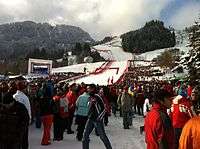
In Tyrol, the Olympic Winter Games have been organized three times so far. In 1964 and 1976 they were held in Innsbruck and 1956 in Cortina. Most of the big annual sporting events in Tyrol take place in winter. The Alpine Skiing World Cup is held in Kitzbühel, Val Gardena, Cortina and Madonna di Campiglio. These races are classics in the Ski World Cup and have a long tradition. A famous biathlon location is in Antholz. There were often held the Biathlon World Championships. Several Nordic Combined World Championships were organized in Val di Fiemme. Part of the Four Hills Tournament is the Bergisel Ski Jump in Innsbruck. A stage of the Tour de Ski is also located in Toblach.
Some summer sports events are also held in Tyrol. The Tour of the Alps take place every year in Tyrol. The tour was launched by the Euroregion Tyrol-South Tyrol-Trentino. It is the successor of the Giro del Trentino, which has been around for over 40 years.[45] In 2017, the UCI Downhill World Championships took place in Val di Sole, near Trento. The BOclassic in Bolzano takes place on New Year's Eve and is one of the best occupied New Year's Eve races in the world.[46] Every year, an ATP World Series tennis tournament is organized in Kitzbühel.
Universities and research institutions
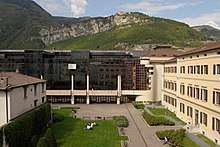

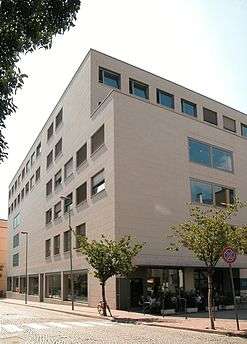
Universities
Colleges
- Philosophical-theological Academy Brixen
- Conservatory "Claudio Monteverdi"
- Tyrolean State Conservatory
- University of Applied Sciences Kufstein
- Health university of Applied Science Tyrol
- MCI Management Center Innsbruck
- Pedagogical University of Applied Science Tyrol
- Ecclesiastical Pedagogical University of Applied Science – Edith Stein
- State College of Health Professions "Claudiana"
Independent research institutions
- Institute for Interdisciplinary Mountain Research; is a facility of Austrian Academy of Sciences
- Eurac Research
- NOI Techpark
- Foundation Bruno Kessler
- Edmund Mach Foundation
- Research Centre Laimburg
See also
- Euroregion Tyrol-South Tyrol-Trentino
- County of Tyrol
References
- "Tyrol". Random House Webster's Unabridged Dictionary.
- The Gentleman's Magazine, Volume 75 (1794), p. 160, at Google Books
- "PressReader.com - Zeitungen aus der ganzen Welt". Pressreader.com (in German). Retrieved 19 July 2017.
- Venice under the yoke of France and of Austria, p. PA1, at Google Books
- Kühebacher, Egon (1991). Die Ortsnamen Südtirols und ihre Geschichte. Die geschichtlich gewachsenen Namen der Gemeinden, Fraktionen und Weiler (in German). Bolzano: Athesia. pp. 470–471. ISBN 88-7014-634-0.
- Finsterwalder, Karl (1990). "Besprechung zu C. Battisti – G. Giacomelli, I nomi locali del Burgraviato di Merano". Tiroler Ortsnamenkunde. Gesammelte Aufsätze und Arbeiten (in German). 3. Innsbruck: Wagner. p. 1127. ISBN 3-7030-0279-4.
- Coolidge, William Augustus Brevoort (1911). . In Chisholm, Hugh (ed.). Encyclopædia Britannica. 26 (11th ed.). Cambridge University Press. p. 1010.
- Fox-Davies, A. C. (1909). A Complete Guide to Heraldry. Thomas Nelson and Sons Ltd. pp. 234–235.
- "Wappen und Banner: Symbole der Autonomie". Province of South Tyrol. Retrieved 11 January 2018.
- "Willkommen". Euroregion Tyrol-South Tyrol-Trentino. Retrieved 20 January 2018.
- "Europäische Integration und Euregio". Euroregion Tyrol-South Tyrol-Trentino. Retrieved 20 January 2018.
- "Das Autonomiestatut". Province of South Tyrol. Retrieved 20 January 2018.
- "ZAHLEN ZUR EUROPAREGION". Europaregion Tirol-Südtirol-Trentino. Retrieved 3 February 2018.
- "Arbeitlosenquote in Südtirol bei 3,4%". suedtirolnews.it. Retrieved 3 February 2018.
- "Istat, Trentino disoccupazione in calo (4,6%)". ansa.it. 7 December 2017. Retrieved 3 February 2018.
- "2015 GDP per capita in 276 EU regions Four regions over double the EU average… …and still nineteen regions below half of the average". European Union. Retrieved 3 February 2018.
- "Jeder 10. Apfel europäische Apfel kommt aus Südtirol". IDM Südtirol. Retrieved 3 February 2018.
- "Südtirol Wein". Südtirol Wein. Retrieved 3 February 2018.
- "Zahlen zur Europaregion" (PDF). Europaregion Tirol-Südtirol-Trentino. Retrieved 3 February 2018.
- "Pferde in Tirol:Das Glück der Erde steht auf vier Beinen". Tiroler Tageszeitung. Retrieved 3 February 2018.
- "ECONOMIC HISTORY" (PDF). Handelskammer Bozen. Retrieved 4 February 2018.
- "Zahlen zur Europregion" (PDF). Bundesland Tirol. Retrieved 4 February 2018.
- "Zahlen zur Europregion" (PDF). Bundesland Tirol. Retrieved 4 February 2018.
- "Dati Provinciali sul Turismo: deludono Roma e Firenze, eccellenti Bolzano, Venezia e Rimini". scenarieconimici.it. Retrieved 4 February 2018.
- "Transit: Mehr als 2,25 Millionen Lkw fuhren 2017 über den Brenner". stol.it. Retrieved 4 February 2018.
- "Mehr Transit-Lkws über den Brenner als in Schweiz". tirol.orf.at. Retrieved 4 February 2018.
- "Flughafen Innsbruck". flugladen.at. Retrieved 30 January 2018.
- "ANAS-Immobilien gehen an das Land über – Vertrag nun unterzeichnet". Provinz Bozen. Retrieved 30 January 2018.
- "Tirol und Südtirol feierten 150 Jahre Brennerbahn mit Railjet". Tiroler Tageszeitung. Retrieved 30 January 2018.
- "Mit Tempo 250 durch die Alpen". Frankfurter Allgemeine. Retrieved 30 January 2018.
- "MOBILITÄT UND VERKEHR". Europaregion Tirol-Südtirol-Trentino.
- "Essen und trinken in Tirol". Tirol Marketing. Retrieved 21 January 2018.
- "Südtirol Wein". Südtirol Wein. Retrieved 21 January 2018.
- "Essen und trinken in Südtirol". IDM Südtirol. Retrieved 21 January 2018.
- "Essen und trinken". trentino.com. Retrieved 21 January 2018.
- "Über uns". Südtiroler Schützenbund. Retrieved 21 January 2018.
- "Brauchtum". Tirol Marketing. Retrieved 21 January 2018.
- "Erfolge". FC Wacker Innsbruck. Retrieved 28 January 2018.
- "storia". AC Trento. Retrieved 28 January 2018.
- "Geschichte". FC Südtirol. Retrieved 28 January 2018.
- "Hall of fame". HC Bozen. Retrieved 28 January 2018.
- "Società". Trentino Volley. Archived from the original on 5 February 2018. Retrieved 28 January 2018.
- "Anche il Kazan si arrende, Trentino BetClic Campione d'Europa per la terza volta consecutiva!". Trentino Volley. Archived from the original on 23 November 2011. Retrieved 28 January 2018.
- "Evers: "Die Wildcard ist eine echte Alternative"". Volleyball Bundesliga. Retrieved 28 January 2018.
- "TOTA – TOUR OF THE ALPS DER EUREGIO". Europaregion Tirol-Südtirol-Trentino. Retrieved 28 January 2018.
- "Silvesterlauf BOclassic". südtirol.com. Retrieved 28 January 2018.




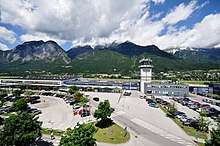

.jpg)